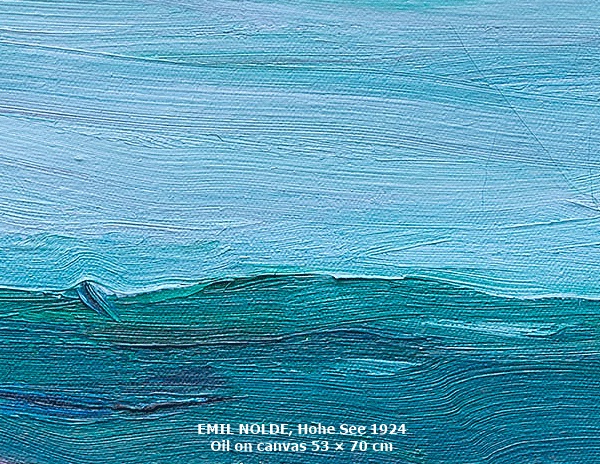Emil Nolde

BECK & EGGELING
Beck & Eggeling Bilker Straße 5 40213 Dusseldorf
Tel.: +49 (0) 2114 91 58 90 Fax: +49 (0) 2114 91 58 99 e-mail:


from 12 October, 2020

My love and enthusiasm exist above all for expressive painting, which is used by painters use to make their visions and sensations recognizable to us, the viewers. This begins in the Renaissance and ends with young painters of today.
Our eyes train themselves with every picture we look at. Often I am not the only one to wonder whether classical panel painting has at some point come to an end, because as early as the second half of the 20th century, artists began to use other forms of expression, such as installation, to present their view of the world in a more contemporary way. Today, the installation, extended by video and digital elements, has become an integral part of contemporary art. And we take for granted what shocked us 60 years ago.
After all, art is basically always about the same thing: depicting the world and all its innumerable facets and making them easier to understand. And painting has still been playing the leading role in this for over five hundred years. It is simply indestructible. We will see how painting is developed further, how it is going to be varied or even be reinvented.
On the other hand, I also ask myself the question: What is still to come? And fortunately, I am always positively surprised. For when one looks back on these five hundred years of painting, one inevitably has to admire the students of painting at the academies today who dare to be measured against this infinitely wonderful history of painting, from Giorgione to Tiepolo to Bacon.
Why am I telling this story? When I look at the painting »Hohe See« (High Seas) by Emil Nolde, which is worth talking about, I have exactly these thoughts. How Nolde has simplified this classic theme of art history in quite an avantgarde manner. How wonderfully he has corrupted reality and found his own chromaticity. How overwhelmed a young painter must still be today about Nolde's painterly radicalism at that time. With just a few long brushstrokes—you can see them clearly through the pasty application of paint—Nolde captures and shapes the theme: high seas—strong wind from the right, we can feel the wind vividly as he sweeps over the sea and floats one or two or even three sailing boats in front of him. No details, no grand narrative, just the picturesque capture of a moment at sea with the simplest means of colour surfaces that together create a unique sound. Shades of blue predominate, from dark to a light Prussian blue, but emerald green also shimmers underneath, and the great sound of colour is enhanced by the violet of the clouds at the top, which are also reflected in the water.
Nolde does not often paint in such an abstract manner, he prefers to formulate his pictorial ideas clearly. Here too he stays very close to the subject, but refrains from painting any details. He is never really abstract, but always with the greatest feeling for the power of colour, and in this picture he leaves it almost entirely up to the colour in its dominance to shape the composition in this way. He also formulates the sailing ships with only a few, sketchy brushstrokes. In this respect, this painting is outstanding in Nolde's oeuvre, not untypical at all, but nevertheless different and convincing through its simplest composition and extensive, simplifying abstraction. Nolde leaves nothing to chance and directs his brushstrokes in a controlled and conscious manner. In 1924 he already had great knowledge of his newly developed, expressive painting style. Nolde now stands in front of the finished painting and is still not satisfied. Then he decides to bring the open composition of the wide sea into greater tension. The picture was too large for him and therefore not exciting enough. He cut off pieces at the top and on both sides and thus reduced the picture detail. The boats are thus pushed to the left edge of the picture and threaten to disappear in the next moment—a special compositional tension is created with the simplest of means. The sea and its boats have been painted endlessly—by van Goyen, Turner, Friedrich, Monet—all great masters of this subject and Emil Nolde, who always depicts it unmistakably and captivatingly.
Our eyes train themselves with every picture we look at. Often I am not the only one to wonder whether classical panel painting has at some point come to an end, because as early as the second half of the 20th century, artists began to use other forms of expression, such as installation, to present their view of the world in a more contemporary way. Today, the installation, extended by video and digital elements, has become an integral part of contemporary art. And we take for granted what shocked us 60 years ago.
After all, art is basically always about the same thing: depicting the world and all its innumerable facets and making them easier to understand. And painting has still been playing the leading role in this for over five hundred years. It is simply indestructible. We will see how painting is developed further, how it is going to be varied or even be reinvented.
On the other hand, I also ask myself the question: What is still to come? And fortunately, I am always positively surprised. For when one looks back on these five hundred years of painting, one inevitably has to admire the students of painting at the academies today who dare to be measured against this infinitely wonderful history of painting, from Giorgione to Tiepolo to Bacon.
Why am I telling this story? When I look at the painting »Hohe See« (High Seas) by Emil Nolde, which is worth talking about, I have exactly these thoughts. How Nolde has simplified this classic theme of art history in quite an avantgarde manner. How wonderfully he has corrupted reality and found his own chromaticity. How overwhelmed a young painter must still be today about Nolde's painterly radicalism at that time. With just a few long brushstrokes—you can see them clearly through the pasty application of paint—Nolde captures and shapes the theme: high seas—strong wind from the right, we can feel the wind vividly as he sweeps over the sea and floats one or two or even three sailing boats in front of him. No details, no grand narrative, just the picturesque capture of a moment at sea with the simplest means of colour surfaces that together create a unique sound. Shades of blue predominate, from dark to a light Prussian blue, but emerald green also shimmers underneath, and the great sound of colour is enhanced by the violet of the clouds at the top, which are also reflected in the water.
Nolde does not often paint in such an abstract manner, he prefers to formulate his pictorial ideas clearly. Here too he stays very close to the subject, but refrains from painting any details. He is never really abstract, but always with the greatest feeling for the power of colour, and in this picture he leaves it almost entirely up to the colour in its dominance to shape the composition in this way. He also formulates the sailing ships with only a few, sketchy brushstrokes. In this respect, this painting is outstanding in Nolde's oeuvre, not untypical at all, but nevertheless different and convincing through its simplest composition and extensive, simplifying abstraction. Nolde leaves nothing to chance and directs his brushstrokes in a controlled and conscious manner. In 1924 he already had great knowledge of his newly developed, expressive painting style. Nolde now stands in front of the finished painting and is still not satisfied. Then he decides to bring the open composition of the wide sea into greater tension. The picture was too large for him and therefore not exciting enough. He cut off pieces at the top and on both sides and thus reduced the picture detail. The boats are thus pushed to the left edge of the picture and threaten to disappear in the next moment—a special compositional tension is created with the simplest of means. The sea and its boats have been painted endlessly—by van Goyen, Turner, Friedrich, Monet—all great masters of this subject and Emil Nolde, who always depicts it unmistakably and captivatingly.
 |
Emil Nolde |
mpefm
GERMANY art press release
Opening hours :
Tue – Fri: 2 – 6 pm
Sat: 12 am – 4 pm
and by appointment

Tue – Fri: 2 – 6 pm
Sat: 12 am – 4 pm
and by appointment
QR of this press release
in your phone, tablet








